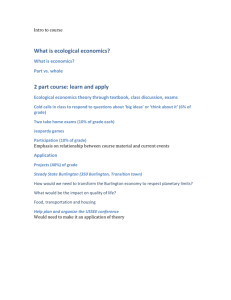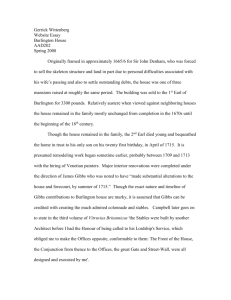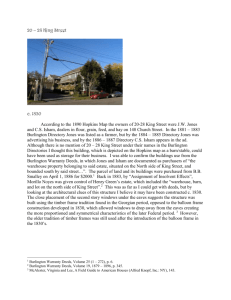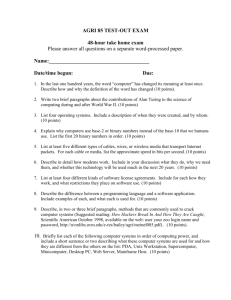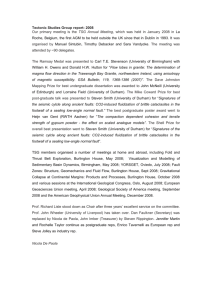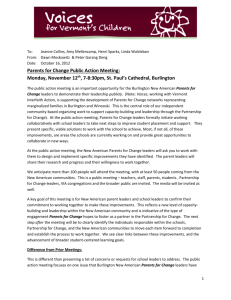Grp7-New_North_End
advertisement
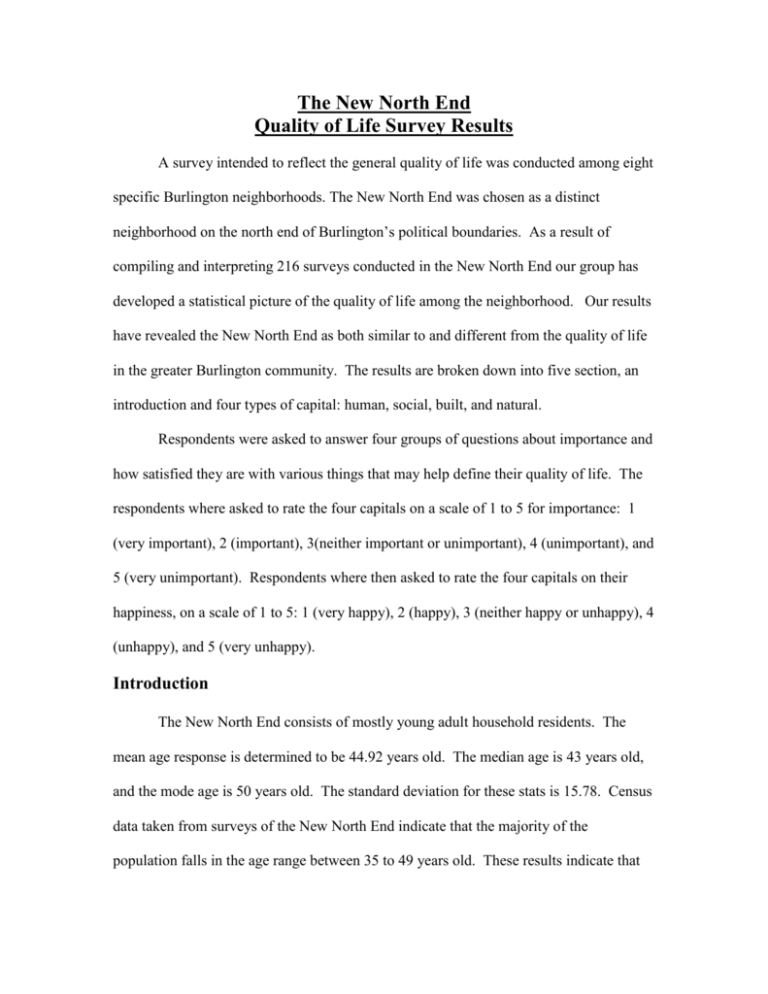
The New North End Quality of Life Survey Results A survey intended to reflect the general quality of life was conducted among eight specific Burlington neighborhoods. The New North End was chosen as a distinct neighborhood on the north end of Burlington’s political boundaries. As a result of compiling and interpreting 216 surveys conducted in the New North End our group has developed a statistical picture of the quality of life among the neighborhood. Our results have revealed the New North End as both similar to and different from the quality of life in the greater Burlington community. The results are broken down into five section, an introduction and four types of capital: human, social, built, and natural. Respondents were asked to answer four groups of questions about importance and how satisfied they are with various things that may help define their quality of life. The respondents where asked to rate the four capitals on a scale of 1 to 5 for importance: 1 (very important), 2 (important), 3(neither important or unimportant), 4 (unimportant), and 5 (very unimportant). Respondents where then asked to rate the four capitals on their happiness, on a scale of 1 to 5: 1 (very happy), 2 (happy), 3 (neither happy or unhappy), 4 (unhappy), and 5 (very unhappy). Introduction The New North End consists of mostly young adult household residents. The mean age response is determined to be 44.92 years old. The median age is 43 years old, and the mode age is 50 years old. The standard deviation for these stats is 15.78. Census data taken from surveys of the New North End indicate that the majority of the population falls in the age range between 35 to 49 years old. These results indicate that the quality of life survey was successful at reflecting the results of an alternative survey data set. Our surveyed population was 38% male and 62% female. Census data for the New North End indicates that their surveyed population was 53% female and 47% male. Based on a question regarding household type, 62% of residents that were surveyed were either individuals living alone or married partners with children. The census data also reflects this statistic and indicate that the number of individuals living alone was slightly more than the number of individuals partnered with children. Since the Census, the New North End might have seen an increase in the number of families. Many respondents described the neighborhood as family oriented. The highest percentage of individuals responding to a survey question regarding income reported earnings of 30-60 thousand dollars a year (35%). In second, 23% of individuals surveyed reported a yearly income of 15-30 thousand dollars and 23% of individuals surveyed reported a yearly income of 60-120 thousand dollars. Only 9% of those who responded have a yearly income of over 120 thousand dollars. Based on a survey question asking residents about their employment status, 71% were employed, 20% were unemployed, and 9% were in school. The New North End is well educated, 64% of surveyed individuals have a bachelor’s degree, a master’s degree, or an associate’s degree. 94% of surveyed individuals were white/Caucasian. Human The community members of the New North End considered investments in themselves slightly less important than the rest of Burlington. They had a mean importance score of 1.57, compared to the overall score of 1.46. The New North End ranked importance of human capital in the following order: Health, Job, Education, Mental Well-Being, and Exercise. The city of Burlington ranked the importance of these items similarly: Health, Mental Well-Being, Education, Job, and Exercise. The primary difference was Mental Well-Being, and Job importance trading places. The neighborhood also rated Jobs and Health as more important than the rest of the city of Burlington. In all other categories, Burlington had a greater importance ranking than the neighborhood. The New North End considered themselves slightly less happy with the investments made in themselves, in comparison to city of Burlington residents as a whole. In Education, Health, Mental Well-being, and Exercise, Burlington’s average happiness scores were all lower than the scores of the New North End, indicating greater happiness. However, the residents were slightly happier with their jobs than the rest of Burlington, with an average score of 2.15 compared to Burlington’s mean score of 2.28. 93 percent of neighborhood residents are covered with Health Insurance. This closely correlates with the overall rate of 91 percent covered with insurance in Burlington. Finally, the average length of time on a specific job for residents was 9.41 years. Social The New North End responses to social capital questions provide for interesting data. When asked about how important relationships with family and friends are to the happiness of ones life, the respondents gave a mean score of 1.31. After looking at the score of actual happiness of this same question, those surveyed said that happiness was a 1.65. Both importance and happiness of this category ranked first in high scores. The same went for safety. Safety’s mean score of importance was a 1.46, and its happiness score was 1.75. Public education was ranked as being the third most important with a score of 1.62, yet it ranked 7th in actual happiness with a score of 2.34. This might suggest that residents are not happy with the current school system. This is a huge deviation, but it also has to be known 46% of these residents have bachelor or graduate’s degrees. Government importance scored fourth with a score of 1.73, but the happiness of government fell to 2.13. Organizations ranked last in importance although it was it was still important to them with a score of 2.18, while the happiness of the organizations ranked 4th with a score of 2.07. The organizations must be doing a good job. When asked about the importance of relationships with people in their own neighborhood, they scored a 2.32. Safety within the neighborhood ranked second in importance and second in happiness, with scores of 1.28 and 1.65 respectfully. The data shows the New North End gave the second highest average mean importance value to social organizations out of all Burlington neighborhoods. The New North End had the highest average mean score for the importance of safety. This might suggests that safety has been an issue in the past and community members are concerned with security. Safety concerns were also convey as a few respondents brought up issues of crime and violence within the community. There is one variation between the happiness of public education and the happiness of higher education. The New North End is the least happy with public education, while Burlington as a whole ranked it third in happiness. The rankings switched with higher education. The New North End ranked higher education third, and the rest of Burlington ranked higher education as dead last. The data suggests that second to the Hill’s neighborhood, the New North End was most happy with the social organizations listed. This finding is fascinating due to the fact that the Hill neighborhood is one of the wealthiest and the New North End is one of the lower income neighborhoods in the survey. Among all neighborhoods’ mean average value for social services, the New North End ranked the highest happiness of Government services (e.g. police and fire protection, city government), a sense of community, and organizations that they belong to, as the most important. The data suggests that the New North End might have stronger values for social services and community then other Burlington neighborhoods. One last aspect of social capital is the beloved pets of the community. The results found that 60% of those surveyed in New North End owned pets, 132 cats, 81 dogs, and 29 other types of pets are owned. The average distribution of cats and dogs per household was .609 cats and .375 dogs. According to those surveyed, the question targeting pet’s importance to the happiness of the individuals life scored a 1.76. All of this information concerning animals and their importance is almost identical to the whole data set for Burlington. Built It appears that residents of the New North End are relatively happy with built capital. People are approximately equally happy with both public and private investments in their neighborhoods, although, private investments such as shops, restaurants, and offices, are regarded to be slightly more important than public investments. Regarding personal investments, residents held a high level of importance on things they own or rent, such as a home, car, furniture, and clothes. This is seen clearly from the New North End’s rating of importance and happiness of various items, many being things owned or rented. Residents rate the following things at almost equal rates of importance and happiness. Items were ranked from greatest to least level of importance, the most important being the home, then food and drink, transportation and household goods equally, personal accessories and entertainment equally. These same things rated according to the level of happiness each brings to the individual or household reads slightly differently. The list from most important to least leads off with pets, followed by home, food and drink, personal accessories and entertainment equally, and transportation and household goods equally. Out of 216 individuals surveyed, about one-third is displeased with their current level of income. Of those 52 individuals who are displeased, on average desire $45,969 more than they currently receive. This speaks volumes; one-third of residents in the New North End are displeased with their current income. This might suggests problems with underemployment, in Burlington. Of the residents surveyed, almost fifty percent of which are unaware with the town’s local currency, Burlington Bread. Natural When asked about natural capital and how it affects people in the New North End, a couple of slight statistical differences were found. The importance of a quality natural environment is slightly more important to the New North End than the rest of Burlington. They had an average of 1.49 versus 1.53 for Burlington. This is a 2.6% difference. As for how happy they are with this aspect of their environment, they are happier than the rest of the city with it. An average happiness rating of 2.01 versus 2.09 gives them a difference of nearly 4%. Conclusion The New North End has revealed its own identity through the findings of the survey. It will be fascinating to see what is to come of the results as the information is presented to the Legacy Project and community member of Burlington. Although Burlington is a relatively small city, its neighborhoods can show distant identities and sub populations that community member might not be aware of if it where not for survey’s like this one.
